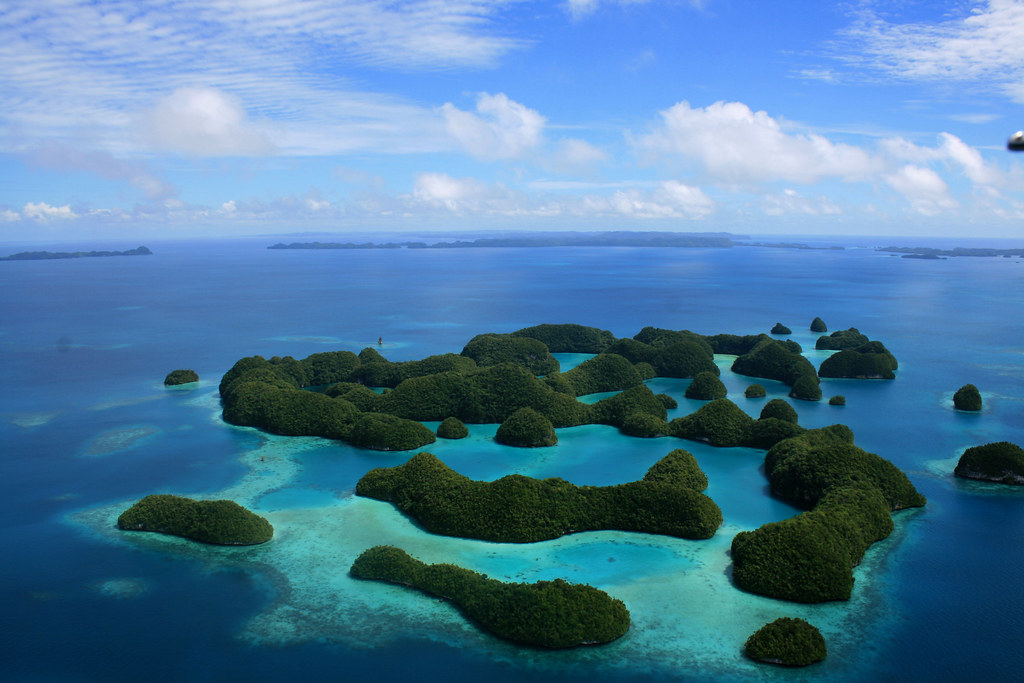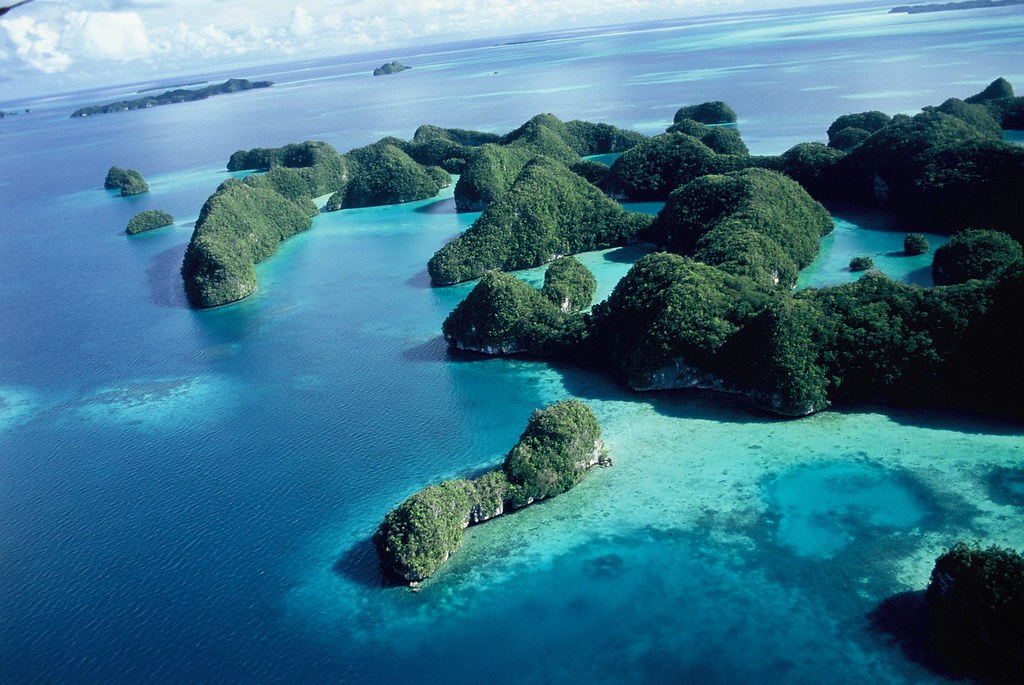2 June 2016
Rock Islands: Palau’s Coral Reef Remnants
Have you ever wondered what would happen to a coral reef if they surfaced, quickly and with some violence? This is what happened in Palau approximately 35 million years ago. The geological name for this event is a subduction episode (more about that later) but the result was that millions of years of coral reef deposit were suddenly thrust above sea level. The result is Palau’s rock islands or Chelbacheb as the place is known to the inhabitants of this western Pacific Ocean nation.
Image Credit
The country of Palau is made up of eight large islands and over 200 islets created by a volcanic event over 100 million years ago. Yet at the southern tip of this archipelago things get even more islandy (if that word didn’t exist then it does now). The Rock Islands lagoon consists of around 450 small islands which cover an area of 18 square miles. They are now uninhabited and many of them are impossible to beach upon because of their shape. 35 million years of erosion has shaped many of them to appear as stone mushrooms.
Image Credit
Image Credit
Image Credit
The erosion has not only been caused by the elements. The tides and rains have been instrumental in forming the shapes, of course. Yet tide pool invertebrates have contributed greatly to the shape of the islands. Plus, below the waves molluscs and parrotfish have chewed and nibbled upon the coral, wearing it down in to its current shape. The parrotfish has teeth which grow continuously, necessary for them to grind up the coral. Once they have digested the edible parts they excrete the rest as sand. This results in sandy beaches further down the coast (each parrotfish can produce up to a ton of beach sand annually) and gives many of the islands their signature overhang.
Image Credit
Image Credit
Image Credit
Above the rock, dense micro-forests festoon the tiny islands. The vegetation is often so thick as to render them impenetrable. Should anyone attempt to traverse the short distance between one end of an island and another it would take them many hours. The greenery clings to the islands with such natural ferocity many look overloaded. No wonder the islands are free from human habitation.
Image Credit
Image Credit
Yet, incredibly, people lived here once, from three thousand years ago up until the early 18th century. There are remains of subsistence villages on some of the islands, abandoned when the populations either became too large to sustain or when a change of climate precipitated a move to larger, safer islands. Since the pre-European occupation ceased Rock Islands were mostly isolated from human interference until the advent of tourism which is strictly controlled. The story of the migration to the larger islands of Palau is still kept alive through the rich oral tradition of the islanders.
Image Credit
Image Credit
There are around 70 salt water lakes which have formed on the Rock Islands, the highest concentration of marine lakes on the planet. This includes the famous Jellyfish Lake. Many of them are connected by huge tunnels, some almost half a mile long, which siphon sea water in and out of the system of lakes. At certain places when the tide is low a kayak can traverse the tunnel. A number of the lakes are not connected to the sea at all which has led to the evolution of endemic species: Darwin would have loved this place if he had had scuba gear.
Image Credit


So how did this all start so many millions of years ago? A subduction event is where two tectonic plates converge and one of them is forced downwards. In the case of the Rock Islands the Pacific Plate slipped below the Philippine Plate, forcing the coral reefs upwards and in to the air. Originally, the exposed reef would not have had the ‘island look’ at all – it would have simply extended over the whole area as a whole entity. The 35 million years of erosion have left us with what we have today. And it is simply beautiful.
Image Credit
First Image Credit
Image Credit
The country of Palau is made up of eight large islands and over 200 islets created by a volcanic event over 100 million years ago. Yet at the southern tip of this archipelago things get even more islandy (if that word didn’t exist then it does now). The Rock Islands lagoon consists of around 450 small islands which cover an area of 18 square miles. They are now uninhabited and many of them are impossible to beach upon because of their shape. 35 million years of erosion has shaped many of them to appear as stone mushrooms.
Image Credit
Image Credit
Image Credit
The erosion has not only been caused by the elements. The tides and rains have been instrumental in forming the shapes, of course. Yet tide pool invertebrates have contributed greatly to the shape of the islands. Plus, below the waves molluscs and parrotfish have chewed and nibbled upon the coral, wearing it down in to its current shape. The parrotfish has teeth which grow continuously, necessary for them to grind up the coral. Once they have digested the edible parts they excrete the rest as sand. This results in sandy beaches further down the coast (each parrotfish can produce up to a ton of beach sand annually) and gives many of the islands their signature overhang.
Image Credit
Image Credit
Image Credit
Above the rock, dense micro-forests festoon the tiny islands. The vegetation is often so thick as to render them impenetrable. Should anyone attempt to traverse the short distance between one end of an island and another it would take them many hours. The greenery clings to the islands with such natural ferocity many look overloaded. No wonder the islands are free from human habitation.
Image Credit
Image Credit
Yet, incredibly, people lived here once, from three thousand years ago up until the early 18th century. There are remains of subsistence villages on some of the islands, abandoned when the populations either became too large to sustain or when a change of climate precipitated a move to larger, safer islands. Since the pre-European occupation ceased Rock Islands were mostly isolated from human interference until the advent of tourism which is strictly controlled. The story of the migration to the larger islands of Palau is still kept alive through the rich oral tradition of the islanders.
Image Credit
Image Credit
There are around 70 salt water lakes which have formed on the Rock Islands, the highest concentration of marine lakes on the planet. This includes the famous Jellyfish Lake. Many of them are connected by huge tunnels, some almost half a mile long, which siphon sea water in and out of the system of lakes. At certain places when the tide is low a kayak can traverse the tunnel. A number of the lakes are not connected to the sea at all which has led to the evolution of endemic species: Darwin would have loved this place if he had had scuba gear.
Image Credit


So how did this all start so many millions of years ago? A subduction event is where two tectonic plates converge and one of them is forced downwards. In the case of the Rock Islands the Pacific Plate slipped below the Philippine Plate, forcing the coral reefs upwards and in to the air. Originally, the exposed reef would not have had the ‘island look’ at all – it would have simply extended over the whole area as a whole entity. The 35 million years of erosion have left us with what we have today. And it is simply beautiful.
Image Credit
First Image Credit
























